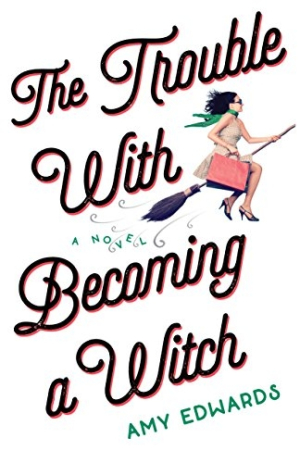The Trouble with Becoming a Witch
The Trouble with Becoming a Witch focuses on its lead character’s winding, knotty, bumpy path to self-acceptance.
In Amy Edwards’s novel The Trouble with Becoming a Witch, a young mother’s marriage becomes more and more constrictive, so she takes baby steps toward personal growth.
Despite her rebellious youth, Veronica has settled into a stolid life as a housewife in suburban Austin, Texas. Life with her critical, controlling husband, Pete, is unhappy; her heart isn’t “soft toward him” anymore. He censors her friendships and her internet use and berates her for her housekeeping, mothering, and post-pregnancy body. Veronica’s burgeoning interest in learning more about Wicca leads to even more marital discord.
Veronica is an interesting lead—a complex heroine who comes to understand who she is, and who her “future self” may be, in fits. She is also a mother who is sometimes ambiguous about motherhood. Life with her one-year-old daughter, Annie, “an incessantly demanding little life-force,” is portrayed as monotonous, though sometimes punctuated by intense and ferocious love. Longing for the excitement of her former career as a boutique owner and seeing her friend Xander’s exciting fashion business grow, she questions what she wants in her relationship with Pete and in other aspects of her life.
Primarily relayed as an interior monologue, Veronica’s transformation from an impassive character to a more independent woman is appealing as it unfolds, slow and multilayered. She is shown feeling dissatisfied with her life as she chafes against social and family pressures to conform. Edwards offers up nuanced, often humorous portraits of Pete and his rigid family; they evince narrow views of society, religion, and acceptable women’s roles.
Both characters are fleshed out, their faults and positive attributes described in shades of gray. Other characters are less described, including Pete’s women relatives, about whom only scant hints are shared, with questions left about what exists behind their bland veneers as perfect wives and mothers.
Because of its lack of action, the narrative drags, and there’s less witchcraft than expected within it. Veronica’s readings and candle lightings are tentative; she never embodies the edgier aspects of being a witch. Her interior monologues are repetitive and reliant on clichés.
Most successful in portraying the stops and starts of Veronica’s empowerment, The Trouble with Becoming a Witch traces her winding, knotty, bumpy path to self-acceptance.
Reviewed by
Rachel Jagareski
Disclosure: This article is not an endorsement, but a review. The publisher of this book provided free copies of the book and paid a small fee to have their book reviewed by a professional reviewer. Foreword Reviews and Clarion Reviews make no guarantee that the publisher will receive a positive review. Foreword Magazine, Inc. is disclosing this in accordance with the Federal Trade Commission’s 16 CFR, Part 255.

